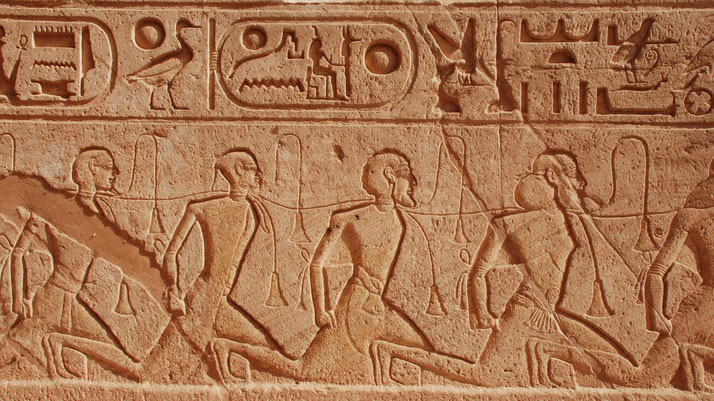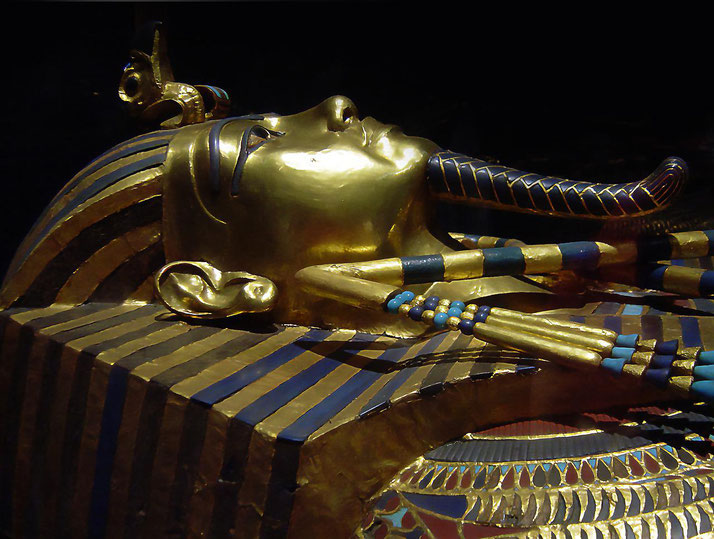Akhenaten: Egypt's religious revolutionary

Akhenaten was a pharaoh who ruled over Egypt during the 18th Dynasty and sparked one of history's most fascinating religious revolutions.
He ascended the throne amidst Egypt's golden age, but triggered a period of turmoil in Egypt's religious traditions by promoting the worship of Aten, the sun disk.
In his fifth year of rule, he abandoned traditional gods, built a new capital city, and even radical transforming Egyptian society.
But such dramatic changes in such a short time would lead to the destruction of his dreams very soon after his death.
Early life
Akhenaten was born in around 1370 BC as Amenhotep IV. He was the son of Pharaoh Amenhotep III and Queen Tiye.
Unfortunately, Akhenaten's upbringing is not well-documented and historians know little about what happened during his formative years.
Regardless, it is safely assumed that he was educated in religious texts and literature, as this was common in the royal household at the time.
He would have also received military training, since was customary for royal princes, who were expected to take part in Egypt's wars of expansion.
During his childhood, Egypt was the richest and most powerful kingdom in the ancient world.
The god Amun was the primary religious deity in Egypt and the priests of Amun were the most powerful social and political group at the time.
They possessed riches and political influence that rivalled that of the pharaohs themselves.
For a number of years, Amenhotep IV may have ruled as co-regent with his father Amenhotep III.
If this was the case, then this arrangement would have allowed Akhenaten to learn more about governing before taking on the role of pharaoh himself.
When Amenhotep III died unexpectedly in about 1351 BC, Amenhotep IV became pharaoh.
He was only about the age of 16 or 17.
What was Akhenaten's religious revolution?
The first few years of Amenhotep IV's reign seem to have been fairly traditional.
He continued to worship the god Amun and remained in the capital city of Thebes, probably at the palace of Malkata, which had been built by his father.
However, in around his fifth year of rule, Amenhotep IV began to promote a new god: Aten.
Aten was represented by the sun disk, and Amenhotep IV claimed that Aten was the one true god.
The pharaoh then renamed himself to Akhenaten ("servant of Aten") to show his dedication to this new deity.
Around the same time, Akhenaten outlawed the worship of all other gods in Egypt.
He closed the temples of other deities, and he had their images removed from public places.
This religious revolution was very controversial, and it was not well-received by all of the people of Egypt.
Many felt that Akhenaten was betraying the traditions of their culture. This led to political unrest, as the powerful priests of Amun lost their influence.
In addition, Akhenaten moved the capital of Egypt from Thebes to a brand new city that he had built, called Akhetaten ("Horizon of Aten").
This massive settlement was erected on a section of the Nile that had never been occupied before.
This was an important for Akhenaten, because he didn't want to build his new Aten temples in an area that had been dedicated to other gods before.
The city plan dictated that all the Aten temples in the city had to face east, towards the rising sun, which meant that it would illuminate the temples doors every morning.
At its peak, Akhetaten is estimated to have housed between 20,000 to 50,000 people, including artists, laborers, and priests devoted to the new religious order.

The conflict with the priests of Amun
Akhenaten's reign experienced a range of conflicts both within Egypt and beyond its borders.
In domestic affairs, he faced opposition from the powerful priesthoods of other gods.
In particular, the priests of Amun were strongly opposed to Akhenaten's religious revolution.
In fact, many were required to become priests in the new Aten religion and forget their old gods.
What made other people angry was the fact that Akhenaten seems to have focused a lot of his time and resources into building his new capital city rather than expanding his empire through military endeavours.
As a result, Akhenaten seems to have ignored important diplomatic relationships that Egypt had built with client kings in the Middle East.
In a series of letters found in the ruins of Akhetaten at Amarna, these kings complain about Akhenaten's neglect of them and his demands for gold and other gifts.

The beautiful Nefertiti
One of the most important figures of Akhenaten reign was his wife, called Nefertiti.
She was Akhenaten's 'chief queen' and is believed to have been of noble or royal birth.
She might have even been the daughter of Ay, who later became pharaoh after Tutankhamun.
In many inscriptions that were made during Akhenaten's reign, she is shown alongside her husband more often than any other Egyptian queen before her.
In many ways, she was Akhenaten's equal. She was given the title "Great Royal Wife", and her name appears in hieroglyphs next to his on public monuments.
Nefertiti also held authority in religious matters. She was depicted taking part in key temple rituals, such as offering sacrifices to the Aten sun disk.
Interestingly, she even had her own temple dedicated to her worship at Akhetaten.
However, Nefertiti disappeared from historical records around the 12th year of Akhenaten's reign.
The exact reason for this remains a mystery, with theories suggesting she may have died, been banished, or even ruled as co-regent under a different name.
How Akhenaten changed Egyptian art
During Akhenaten's reign, there was a significant change in the style of Egyptian art.
The traditional idealized images of kings and gods were replaced by more realistic depictions of everyday life.
This change is most evident in the artwork produced at Akhetaten, which depicts the royal family in a much more naturalistic style than had been seen before.
Many historians wonder whether this new art style may have been inspired by Akhenaten's belief that Aten was present in all things, including humans.
This is because the sun disk of the Aten featured prominently in artwork from this time.
The disk was often portrayed with arms outstretched, symbolizing Aten's rays of light.
How did Akhenaten die?
Around the 12th year of his reign, Akhenaten's health may have begun to decline.
In the 17th year, perhaps around 1335 BC, Akhenaten died suddenly.
His exact cause of death is unknown, but the two main theories is that it may have been natural or due to assassination.
It has long been believed that Akhenaten may have suffered from a physical deformity, which is seen in the portrayal of his body in artwork from this period.
Unfortunately for Akhenaten, his religious revolution did not last long after his death.
By the end of his reign, the pharaoh was unpopular with both the Egyptian common people and the wealthy ruling class.
When his son Tutankhamun took the throne, he began to revert back to the worship of Amun.
He reopened the temples of other gods and moved the capital back to Thebes.
It is likely that Tutankhamun simply felt he needed to undo his father's changes in order to regain the support of the people.
He was helped by Horemheb, a high-ranking military official and later pharaoh, who also played a role dismantling Akhenaten's religious reforms and restoring traditional Egyptian religious practices.

Erasing the memory of Akhenaten
The ancient Egyptians made a concerted effort to erase the memory of Akhenaten and his time in power.
To do this, his name was removed from public monuments, and his images were destroyed.
This process was done so thoroughly that Akhenaten relatively was unknown in Egyptian history until the 19th century, when Amarna was rediscovered.
In particular, the tomb of Akhenaten was discovered by Flinders Petrie in 1907, and Tutankhamun's tomb was excavated by Howard Carter in 1922.
The discovery of these tombs, along with the many artworks and artifacts that were found in the ruins of Akhetaten, has given us a much fuller picture of this controversial figure.
Further reading
What do you need help with?
Download ready-to-use digital learning resources
Copyright © History Skills 2014-2025.
Contact via email
With the exception of links to external sites, some historical sources and extracts from specific publications, all content on this website is copyrighted by History Skills. This content may not be copied, republished or redistributed without written permission from the website creator. Please use the Contact page to obtain relevant permission.





